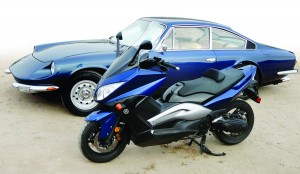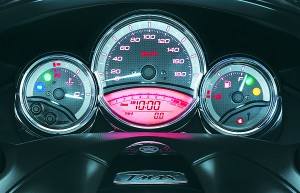When Yamaha introduced the boisterous new Vmax streetfighter last summer, another “Max” had already slipped into the market under the radar. Billed as a cross between a sportbike and a scooter, admittedly the 2009 Yamaha Tmax looks like neither fish nor fowl at first glance-but then again neither did the original Chrysler minivan, the hamburger, or The Artist Formerly Known as Prince. Yet in time such crossover pioneers, if they can back up their amorphous looks with solid function and value, eventually become mainstream. We predict the Tmax will, too.
Hardcore motorcyclists may give the stink eye to anything smacking of scooterdom. But there are actually few such suggestions on the Tmax. While it does feature step-through construction and feet-on-the-floorboards seating, its swoopy bodywork more suggests a small sport-touring bike. Likewise, the Tmax is simply too big to register visually as a scooter thanks to its 7-foot, 2-inch length, fat 120/70-R15 front and 160/60-R15 rear tires, and triple disc brakes with four-piston front calipers.
Our impressions after putting more than 500 miles on it are positive. With a fuel-injected, liquid-cooled and balance-shaft-equipped 499cc parallel-twin engine, the Tmax surprisingly offers true 100-mph-plus performance capability. Just turn the key in the central ignition switch and hit the start button (after raising the sidestand and squeezing either brake lever). The engine idles immediately, and getting underwa

y is as simple as twisting your wrist. It’s also blissfully quiet with only a modest purr emanating from the big muffler can.
Unlike a typical motorcycle, where you can use the clutch and gearbox to pick the rev range you want to use, the Tmax simply jumps to its torque peak of about 5,000-5,500 rpm and pretty much stays there. This is not a bad thing; it offers decent acceleration (at least by car standards) and then goes about its business with zero fuss. With no tank to grip with your knees, no clutch to operate and no levers to work with your feet, the Tmax requires some adaptation-but it also requires less of the rider than any motorcycle.
Puttering down to the gas station to top up the Tmax’s fuel tank and grab some groceries revealed a civilized overall ride. The acceleration is brisk but not dramatic, the handling is neutral and predictable, the suspension is reasonably effective and the brakes are responsive without being touchy. Chassis geometry feels similar to a touring motorcycle’s, with a long 62.2-inch wheelbase and relaxed steering geometry, so the Tmax yields familiar handling. Despite using a progressive aluminum chassis the claimed wet weight is a hefty 489 pounds-definitely motorcycle rather than scooter territory. While the mass helps the Tmax feel planted and secure at highway speeds, new riders may find it unnerving during slow going.
The Tmax has a single multipurpose key system, located on the handlebar nacelle, to operate the ignition, seat release and fork lock. Although it’s a clever system, it proved somewhat balky in use. Under the dual seat is a storage area suitable for a small duffel or else a full-coverage helmet (nestled in upside down) and a jacket.
Heading to the Monterey Historic Automobile Races early on an August morning, the Tmax blended into California’s northbound Highway 101 traffic as silver dewdrops streaked across the windscreen. Like a poor man’s wind tunnel, the phenomenon showed how good the windscreen and front fascia are at directing wind and cold around the rider. Although we found helmet buffeting annoying at brisk touring speeds, a taller accessory ‘screen is available, as are side wind deflectors to provide even more protection. So equipped, we’d have zero hesitation about embarking on a California-to-Maine marathon tomorrow.

While the seat itself is nicely contoured for long travel days, you can only place your feet below you as if seated at a chair, or else stretched forward in a La-Z-Boy style. But chairs are not motorcycles, and during each 250-mile stint we wished for a more rearward foot position. Nonetheless, the Tmax offered plenty of power to hang with or dispatch any freeway traffic, and it was great fun to tuck into a line of sportbikes or cruisers-and keep up to their riders’ utter amazement. At an indicated 70 mph the engine spins along at 5,000 rpm with virtually imperceptible vibration. And the Tmax returned just over 46 mpg for the trip, putting its range at more than 180 miles per four-gallon fill-up.
Ultimately desire is the best judge of any motorcycle, and the $7,999 Tmax kindled in us a desire to ride each and every morning. With its simple, quiet operation, ample performance, motorcyclelike handling and built-in storage, it’s a magnetic alternative to entry-level motorcycles like the venerable Kawasaki Ninja 500R. And a few small details aside, for general use it is every bit as good.
If you are interested in the 2009 Yamaha Tmax, you might also be interested in seven additional 250-1200cc Scooter motorcycle road tests and spotlights for new motorcycle riders
[This 2009 Yamaha Tmax Scooter Road Test was originally published in the January 2009 issue of Rider magazine]







Sounds like a pretty much vanilla review. “Simple”, “quiet”, “ample”? That is supposed to tell us something? Or make us want to cough up $8K for something which surprisingly keeps up with traffic? Who says anyone was “amazed” by this, especially by a 500cc bike? And the statement about a balky key just leaves more questions. Either explain or leave it out. I have never encountered a “balky” key.